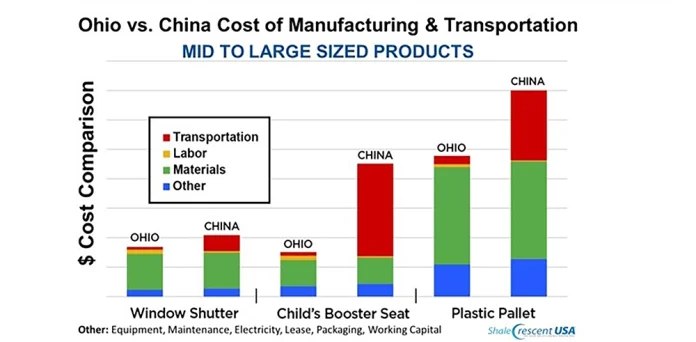by Greg Kozera, director of marketing and sales, Shale Crescent USA
A new study by Shale Crescent USA and Jobs Ohio directly shows the United States is the most profitable place to manufacture plastics products. For the past four decades, US manufacturers have migrated overseas to China primarily due to cheaper foreign labor and a decreasing US energy supply. Times have changed. The US now leads the world in natural gas production by a vast amount. For example, if the Shale Crescent USA region – Ohio, Pennsylvania and West Virginia – were a country, it would rank as the third largest natural gas producer in the world, only behind the rest of the United States at No. 1 and Russia at No. 2.
The long-held belief – it is cheaper to import plastic-based manufactured goods – is no longer true. The forces and trends that led to offshoring US manufacturing operations have reversed course and now are favoring domestic production. China has lost its manufacturing competitive advantage and the annual $25 billion of exported plastics-based goods from China represents a vulnerable and accessible market share opportunity for US operations.
Resin Availability and Transportation Drive Costs
Feedstock/resin, energy and transportation are the largest cost drivers of globally produced plastic-based goods. Proximity to low-cost raw materials coupled with direct access to consumer markets provides US manufacturers with significant cost advantages over China-based competitors who must import raw materials and export finished goods. The elimination of trans-continental supply chains results in cost savings that magnify a competitive advantage. This paradigm shift favoring US operations has accelerated over the past decade. These changes are fundamental, long term and will continue for the foreseeable future.
The US Shale Gas revolution resulted in low-cost natural gas and natural gas liquids, which are used to produce plastic resin. Ohio, West Virginia and Pennsylvania combined now produce over one-third of US natural gas supply and over one and a half times more natural gas than the entire country of China. China is energy deficient and is reliant on global supply chains to either import plastic resin or produce resin from much costlier oil-based Naphtha.
Just west of Pittsburgh, Pennsylvania, Shell Chemicals’ world-scale ethylene cracker with a capacity of producing 3.5 billion pounds of polyethylene resin is close to start up. Local plastics manufacturing operations will enjoy the benefit of regionally sourced resin eliminating long and costly logistics. This local supply will translate to premium services including shorter transit times, decreased working capital, greater feedstock flexibility and other cost-saving factors. According to IHSMarkit, over 70% of today’s polyethylene and polypropylene demand remains within a day’s drive of the Ohio River Valley.
A nonprofit in Ohio was founded six years ago by a group of industry and community leaders to attract high-wage manufacturing jobs. No longer the rust belt region, the organization has branded the Ohio River Valley states of Ohio, Pennsylvania and West Virginia as the Shale Crescent USA.
The region is unique for manufacturers. It is the only place in the world at scale where a company can build on top of its energy and feedstock and in the middle of its customers thus eliminating unnecessary transportation – 50% of the US population is within a day’s drive.
With the new US energy advantage, advancement in manufacturing technologies and steady Chinese wage rate increases, China’s hold on low manufacturing costs has evaporated. Manufacturing in these Ohio River Valley states is not only more profitable, but it is also more sustainable because the energy, feedstock and consumers are here. The carbon footprint of shipping products and the Middle East oil required to manufacture them in China halfway around the world is eliminated. Container costs are still over triple pre-pandemic costs.
One manufacturer the organization has been working with couldn’t get its feedstock from China during the pandemic. The manufacturer replaced it with suppliers in the region. Now 100% of its feedstock and sales are regional. This has dramatically reduced transportation and raw material costs. The manufacturer added two production lines and is adding two more in 2023. In addition, the manufacturer has dramatically reduced its carbon footprint and eliminated pollutants associated with ocean shipping.
US manufacturers now have a generational opportunity to increase market share, profitability and reliability. They can also reduce their carbon footprint, be more sustainable and lower costs. Will US companies take advantage of the energy under their feet?
Greg Kozera is the director of marketing and sales for Shale Crescent USA. He is a professional engineer with a master’s in environmental engineering and over 40 years of experience in the energy industry. Kozera is a leadership expert, high school soccer coach, professional speaker and the author of four books and numerous published articles.
© 2022 Shale Crescent USA
More information: gkozera@shalecrescentusa.com or www.shalecrescentusa.com





